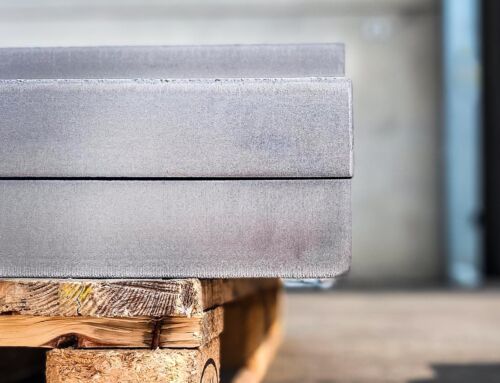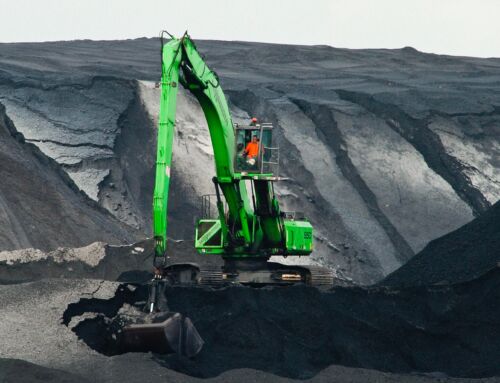Dillimax 690 is a high-strength structural steel that is revolutionizing several industries. This article will explore the unique features, benefits, and practical applications of this innovative material.
Key features of Dillimax 690 steel
- Dillimax 690 is a high-strength structural steel that combines excellent mechanical properties with good machinability. Its chemical composition and manufacturing process are optimized to offer a balance of strength, ductility and ease of use in various industrial applications.
- Mechanical properties and structure:
The steel has a minimum yield strength of 690 MPa and a tensile strength between 770 and 940 MPa. Its tempered martensitic structure, characterized by fine grain (ASTM No. 8 or finer), contributes to its high resilience, maintaining Charpy-V values above 27 J even at -40°C. Elongation at break, not less than 14% for thicknesses up to 50 mm, ensures good ductility despite high strength. - Composition and weldability:
The chemical composition of Dillimax 690 is carefully controlled, with a low carbon content (≤ 0.20%) and a balance of elements such as manganese, chromium, molybdenum, and nickel. This formulation ensures a carbon equivalent (CEV) of no more than 0.65, promoting excellent weldability. The steel is compatible with a variety of welding processes, including SAW, GMAW, SMAW and FCAW, although preheating is recommended for thicknesses over 30 mm. - Workability and treatments:
The Dillimax 690 offers good formability, with a minimum bend radius of 3 times the thickness for cross bends. Hot forming can be carried out between 850 and 1000°C. Supplied in hardened and tempered condition, the steel requires no further heat treatment after machining, optimizing production time. - Tolerances and formats:
Dimensional tolerances meet EN 10029 standards, with special attention to flatness. Steel is available in sheets and plates with thicknesses from 6 to 150 mm, widths up to 3500 mm and lengths up to 18000 mm, offering flexibility for various design needs. - Applications and compliance:
Conforming to EN 10025-6 (Grade S690QL) and ASTM A514 standards, Dillimax 690 finds use in high-strength civil construction, heavy machinery components, offshore structures and special vehicles. Its resistance to atmospheric corrosion is comparable to unalloyed structural steels, but surface protection is recommended for particularly aggressive environments.
Types of steel: a comprehensive guide to choosing the right one
Dillimax 690 steel is not just a material, but a family of high-performance steels, each with specific features and characteristics to meet different engineering needs. Let’s find out the three main variations together:
- Dillimax 690B: The silent force.
This quenched and tempered steel is distinguished by its high ductility and excellent weldability, making it ideal for the fabrication of slender, lightweight structures that must still carry considerable loads. Think dump trucks, cranes, bridges and offshore structures-the Dillimax 690B is the winning choice for projects that require strength and flexibility at the same time. - Dillimax 690T: Tenacity without compromise.
The distinguishing feature of this steel is its toughness, which is achieved through a quenching treatment that increases its elastic limit. Perfect for the construction of metal structures, transportation facilities and lifting platforms, the Dillimax 690T provides strength and reliability even under the most demanding conditions. - Dillimax 690E: High performance, low weight.
If your priority is optimizing weight without sacrificing performance, the Dillimax 690E is the steel for you. Easy to machine and characterized by a high elastic limit, this steel is perfect for the construction of earthmoving machinery, pressure vessels, and components of goods handling machinery.
Choosing the right steel
Each project has specific needs. Choosing the right Dillimax 690 steel depends on several factors, including:
- Applied load: Evaluate the forces that will bear on the structure and choose steel with the appropriate tensile and yield strength.
- Stresses: If the structure is subject to vibration or dynamic loads, opt for a steel with high fatigue strength such as Dillimax 690T.
- Environmental conditions: If the structure is exposed to weathering or extreme temperatures, choose a steel with adequate corrosion resistance or thermal stability such as Dillimax 691.
- Weight: If weight is a critical factor, the Dillimax 690E offers an excellent strength-to-weight ratio.
Advantages of using Dillimax 690
The use of Dillimax 690 offers numerous benefits that make it an excellent choice for advanced engineering projects. These benefits translate into significant improvements in the performance, efficiency and sustainability of the applications in which it is used.
- Reduced structural weight: Due to its high strength, Dillimax 690 makes it possible to significantly reduce the thickness of components while maintaining the same mechanical performance. This characteristic leads to a substantial decrease in the overall weight of the structures, which can be as much as 20-30% compared to conventional steels. Weight reduction translates into multiple cascading benefits: lower fuel consumption in vehicles, increased carrying capacity in mobile structures, and reduced transportation and installation costs for large infrastructure projects.
- Improved mechanical performance: The high strength of Dillimax 690 not only allows for lighter structures, but also offers a significant improvement in overall mechanical performance. This results in increased load capacity, improved fatigue resistance and superior impact resilience. These features extend component life and increase safety in critical applications, such as in offshore structures or heavy machinery under intense stress.
- Increased component longevity: The combination of high strength and good wear resistance of Dillimax 690 contributes significantly to increased component longevity. This advantage is particularly evident in applications subject to repeated mechanical stress or in abrasive environments. Extending the service life of components not only reduces maintenance and replacement costs in the long run, but also decreases downtime, increasing overall operational efficiency.
- Savings in production and maintenance costs: Although the initial cost of Dillimax 690 may be higher than that of conventional steels, the long-term savings are considerable. The reduction in material needed, combined with less frequent replacement and maintenance, leads to a significant reduction in costs over the product life cycle. In addition, the steel’s good machinability allows production processes to be optimized, reducing processing time and costs.
- Increased energy efficiency: Using the Dillimax 690 contributes to energy efficiency in several ways. In mobile applications, such as vehicles or machinery, weight reduction translates directly into lower energy consumption. In fixed structures, such as buildings or bridges, the use of thinner sections can improve thermal insulation and reduce energy requirements for heating or cooling. These benefits not only lower operating costs, but also contribute to the reduction of environmental impact.
- Design flexibility: The features of the Dillimax 690 offer designers greater creative freedom. The ability to use thinner and lighter sections opens up new possibilities in structural design, allowing the creation of bolder and more innovative shapes. This advantage is particularly appreciated in modern architecture and advanced vehicle design.
- Environmental sustainability: The use of the Dillimax 690 aligns with environmental sustainability goals. Reducing the amount of material used, coupled with the longer life of the components, helps to decrease the ecological footprint of the projects. In addition, the complete recyclability of steel at the end of its life cycle fits perfectly with the principles of the circular economy.
Industrial applications of the Dillimax 690
Dillimax 690 finds use in a wide range of industries due to its outstanding mechanical properties and versatility. Its ability to combine high strength, good workability and durability makes it ideal for demanding applications in various fields.
- Construction sector: In construction and infrastructure, the Dillimax 690 is revolutionizing the design of high-load structures. It is used in the construction of beams for tall buildings, where reducing structural weight is crucial to optimize space utilization and reduce foundation costs. In bridges and viaducts, the use of this steel makes it possible to create slimmer and lighter structures, allowing longer spans and bolder designs. An emblematic example is the Millau Viaduct in France, where the use of high-strength steels enabled the creation of a structure that is as imposing as it is elegant.
- In offshore structures, such as oil platforms and marine wind farms, the Dillimax 690 offers an ideal balance between stress resistance and light weight, crucial in corrosive marine environments subject to high dynamic loads.
- Mining industry: The mining industry benefits greatly from the properties of the Dillimax 690. It is used in the manufacture of large excavators and mechanical shovels, where the combination of wear resistance and light weight increases operating efficiency and reduces fuel consumption. Conveyor belts reinforced with Dillimax 690 components offer increased durability and loading capacity, optimizing material handling operations. In underground mines, support structures made from this steel provide superior safety due to their high strength and ability to absorb impact energies.
- Automotive sector: The automotive industry, particularly in the heavy commercial vehicle segment, is increasingly adopting the Dillimax 690. It is used in the manufacture of truck chassis, where weight reduction directly translates into increased payload capacity and improved fuel efficiency. In automotive safety components, such as side intrusion bars, the high strength of Dillimax 690 offers superior protection in case of impact. For special vehicles, such as military or rescue vehicles, this steel allows the combination of high protection and mobility, essential features in critical operational scenarios.
- Energy Industry: In the energy industry, the Dillimax 690 is playing a key role in the transition to renewable sources. It is used in the production of wind turbine components, such as towers and blade support elements, where its strength allows for taller and more efficient structures. In solar applications, support structures made from this steel offer increased durability and weathering resistance. In the oil and gas industry, Dillimax 690 pipes and structures provide superior performance in extreme conditions, both onshore and offshore.
- Agricultural Machinery: Modern agriculture benefits from the use of the Dillimax 690 in high-performance machinery. Frames for tractors and harvesters made from this steel offer increased load-bearing capacity and fatigue resistance, extending the service life of machinery. In components for plowing and harvesting equipment, such as the articulating arms of combine harvesters, Dillimax 690 enables lighter but stronger structures, improving operational efficiency and reducing soil compaction.
Practical examples of the application of the Dillimax S690
The Dillimax S690 finds use in a wide range of practical applications, demonstrating its versatility and outstanding performance in a variety of industries. Let’s explore some concrete examples that illustrate how this high-strength steel is revolutionizing various fields of engineering and manufacturing.
- Innovative bridge construction: The Millau Viaduct in France is a prime example of the use of high-strength steels such as Dillimax S690. This extraordinary cable-stayed bridge, with pylons reaching 343 meters in height, takes advantage of the properties of high-strength steel to achieve an incredibly slender and lightweight structure. The use of steels similar to Dillimax S690 made it possible to significantly reduce the weight of the structure, allowing longer spans and decreasing construction and maintenance costs. The superior strength of steel also ensures greater durability of the structure, which is critical for a work of this magnitude.
- State-of-the-art port cranes: In modern ports, container handling cranes are a crucial application for the Dillimax S690. These huge structures require a perfect balance between strength, lightness and load-bearing capacity. The use of the Dillimax S690 in crane booms makes it possible to extend the reach while maintaining excellent stability. Reducing the overall weight of the structure also decreases energy consumption during operations, increasing the overall efficiency of the port.
- Armored vehicles for military applications: In the defense sector, the Dillimax S690 finds use in the construction of light armored vehicles. Its high strength allows for superior protection against bullets and explosions while maintaining low vehicle weight. This results in increased mobility and maneuverability in the field, features that are crucial in complex operational scenarios. In addition, the good weldability of the Dillimax S690 facilitates the fabrication of complex and modular structures, which are essential for the versatility of modern military vehicles.
- Offshore oil and gas platforms: The offshore oil industry represents one of the most demanding application areas for the Dillimax S690. In mining platforms, this steel is used for critical components such as support legs and supporting structures. Its resistance to corrosion in marine environments, combined with high mechanical strength, allows for lighter but extremely strong structures. This results in increased platform stability in adverse weather conditions and reduced maintenance costs in the long run.
- Large wind turbines: In the renewable energy sector, the Dillimax S690 is revolutionizing wind turbine design. It is used in the construction of the latest generation of wind blade support towers, which reach ever greater heights. The use of this high-strength steel allows for taller and more stable structures capable of taking advantage of stronger and more consistent winds at higher altitudes. The reduction in tower weight, made possible by the properties of the Dillimax S690, also facilitates transportation and installation of these clean energy giants.
- Mining machinery: In open pit mining, giant excavators equipped with buckets made of Dillimax S690 represent the state of the art in handling large volumes of material. The wear resistance and high toughness of this steel significantly extend the life of the buckets, reducing maintenance downtime. The relative lightness of the material also allows the excavator’s loading capacity to be increased, improving the overall efficiency of mining operations.
- Heavy commercial vehicle chassis: In the transportation sector, the Dillimax S690 finds application in large truck and trailer chassis. The use of this steel makes it possible to reduce the weight of the frame while maintaining or even increasing the load-bearing capacity. This translates into improved fuel efficiency and reduced emissions, aspects that are increasingly crucial in the transportation industry. The superior durability of the Dillimax S690 also ensures a longer vehicle life, optimizing the return on investment for transportation companies.
These practical examples demonstrate how the Dillimax S690 is helping to push the limits of engineering and design in various industries. Its unique combination of strength, light weight and durability makes it a material of choice for applications requiring high performance under extreme conditions. As the industry continues to evolve toward more efficient and sustainable solutions, the role of the Dillimax S690 is likely to grow, opening up new possibilities for innovation and technological advancement.







